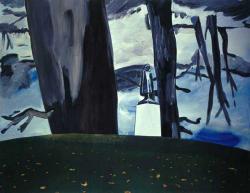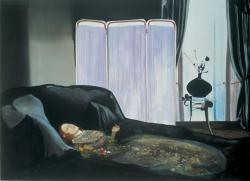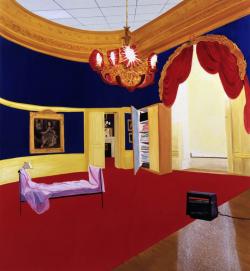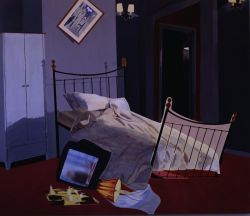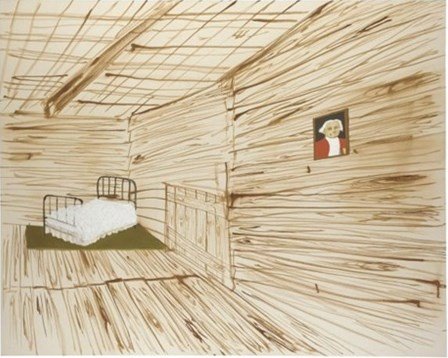
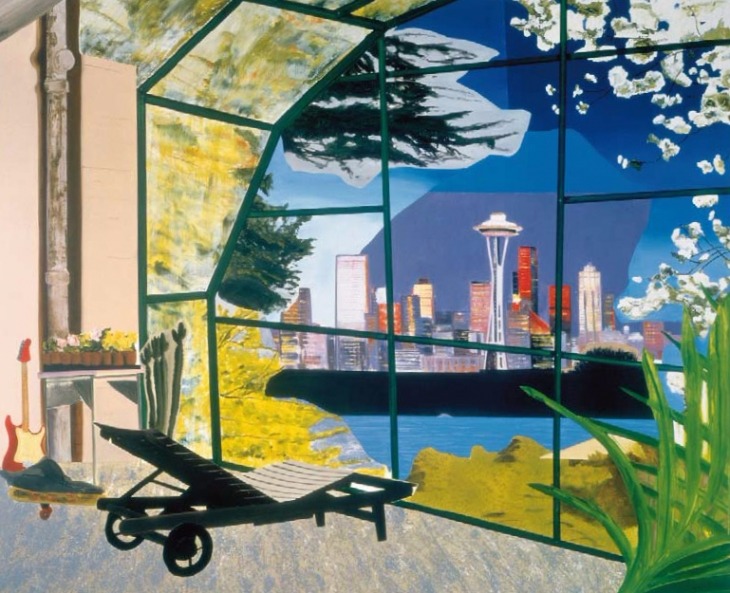

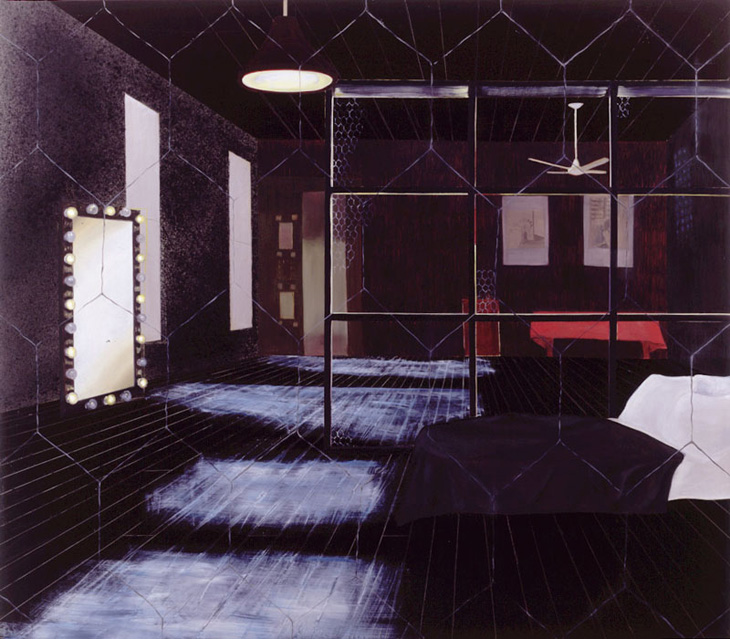

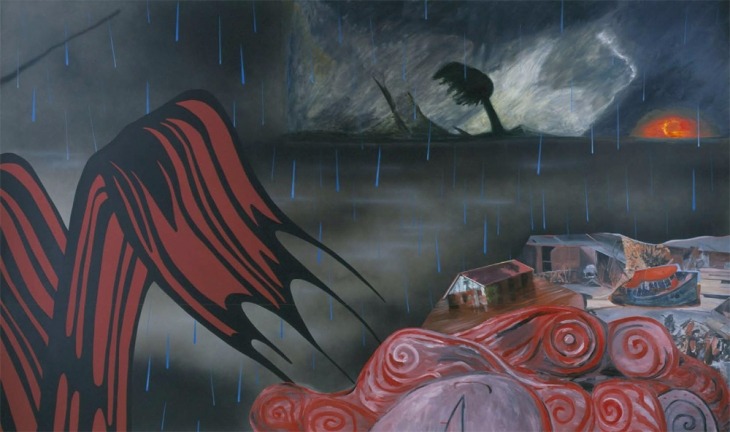
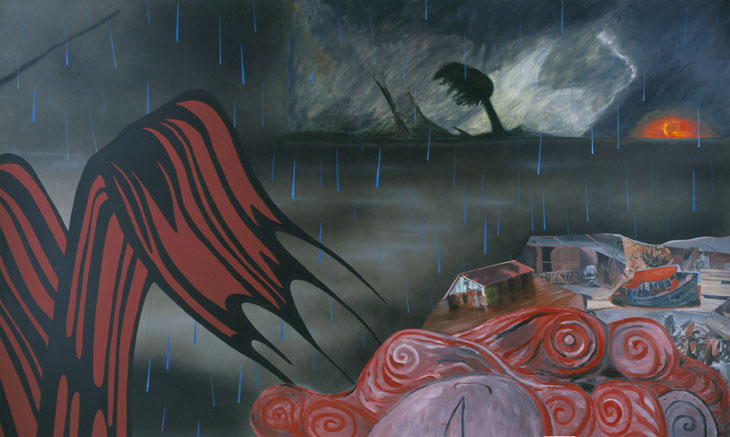

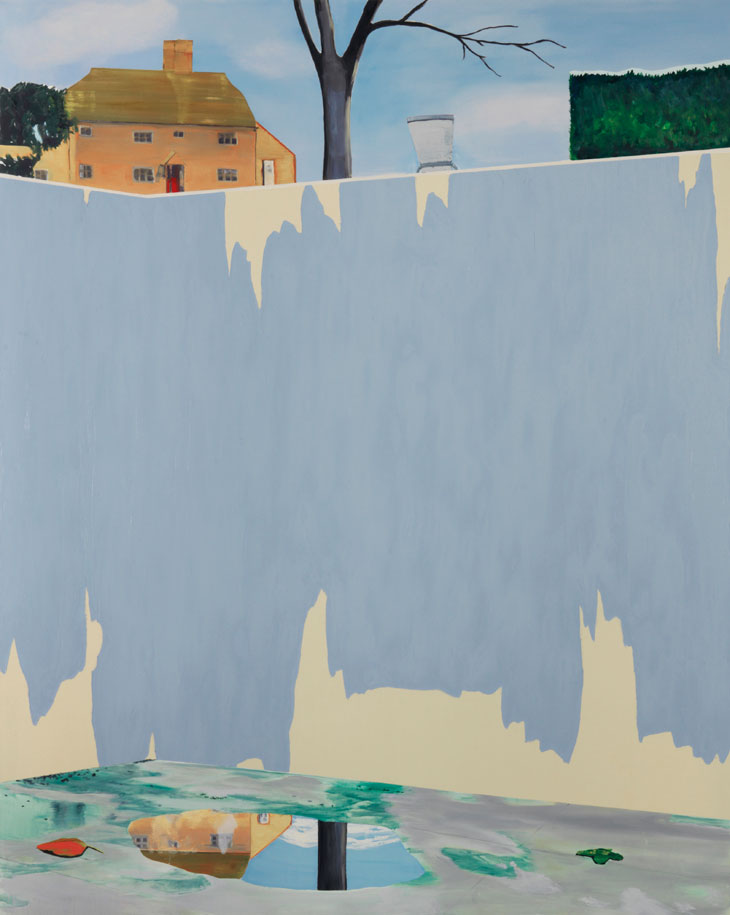

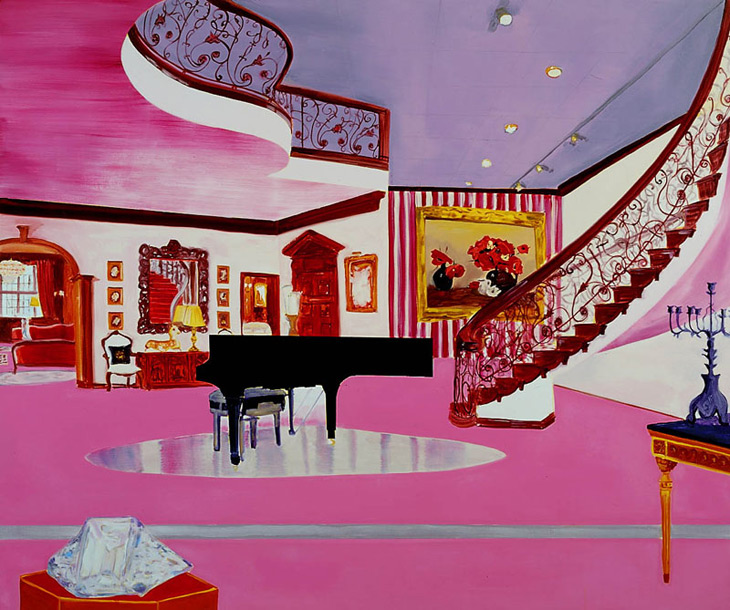
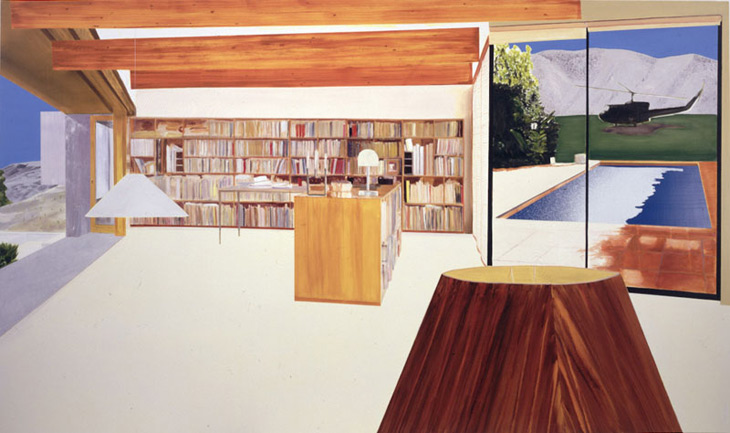
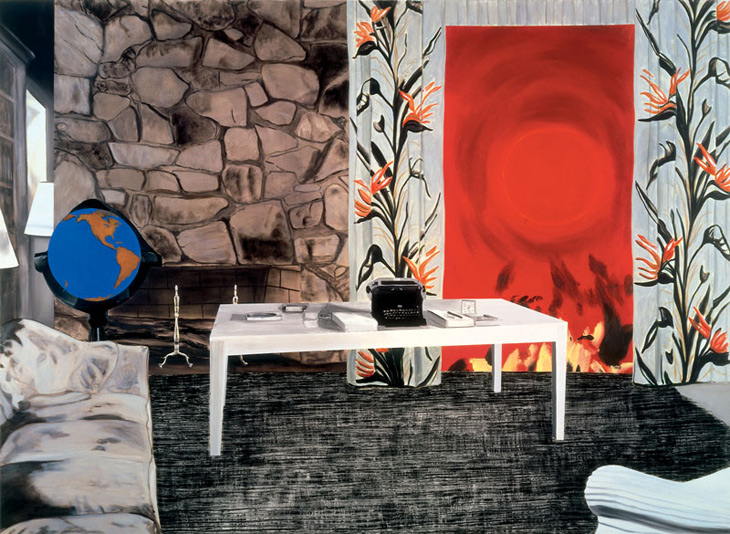

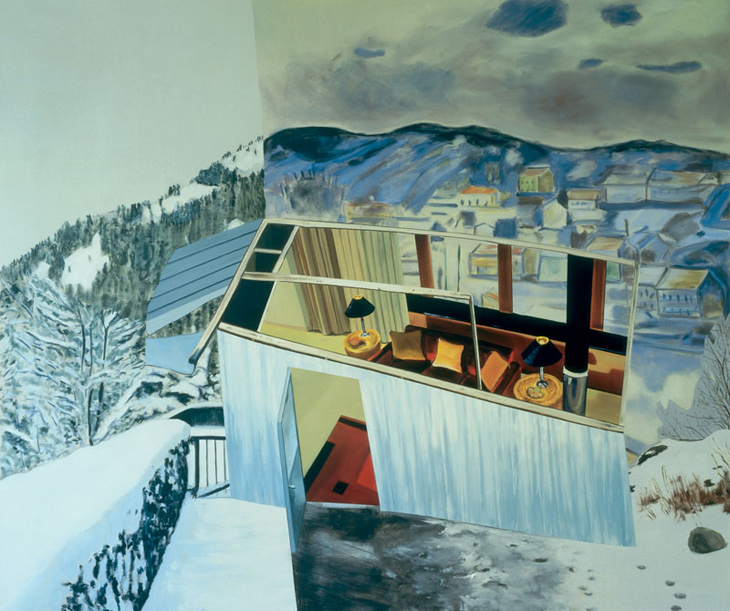
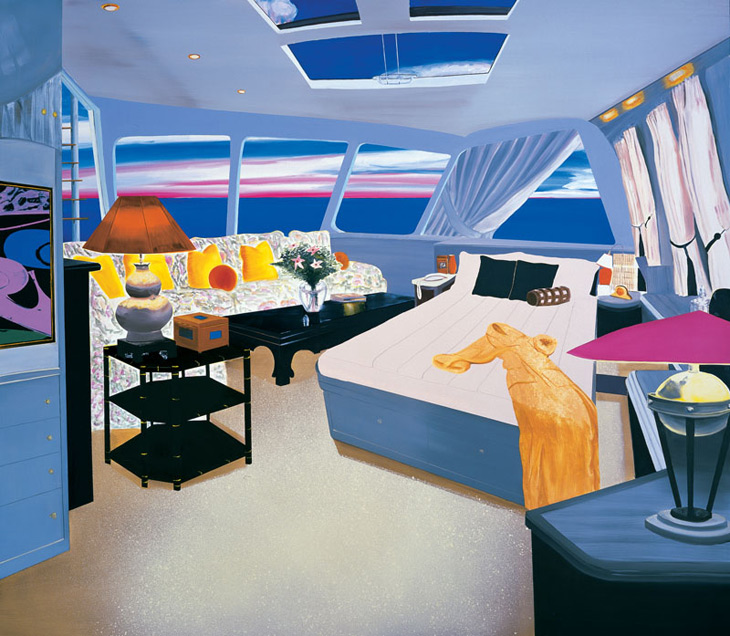


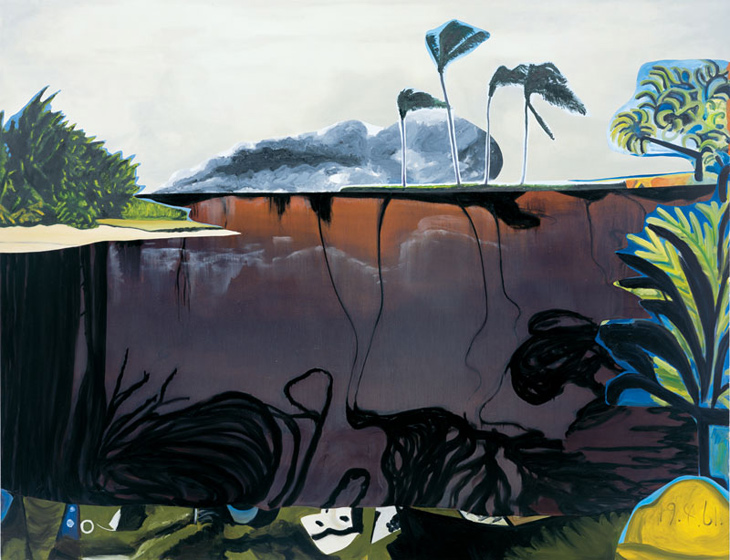

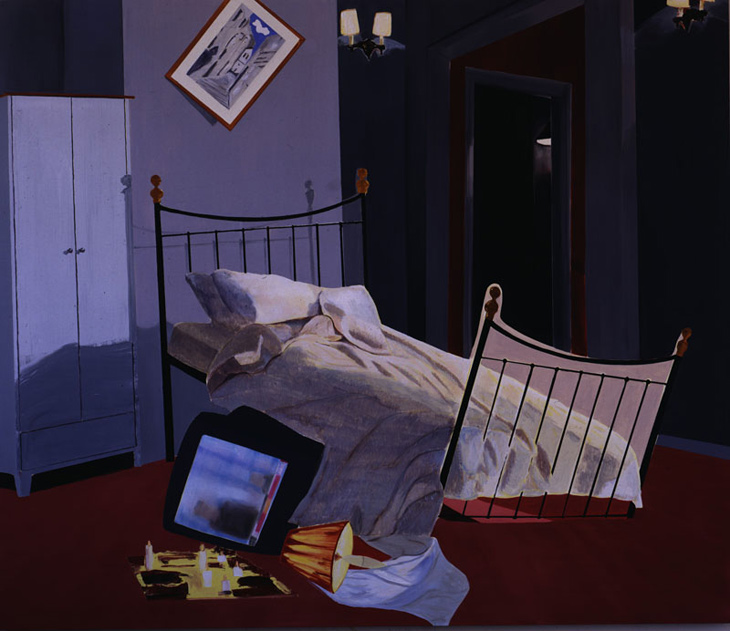
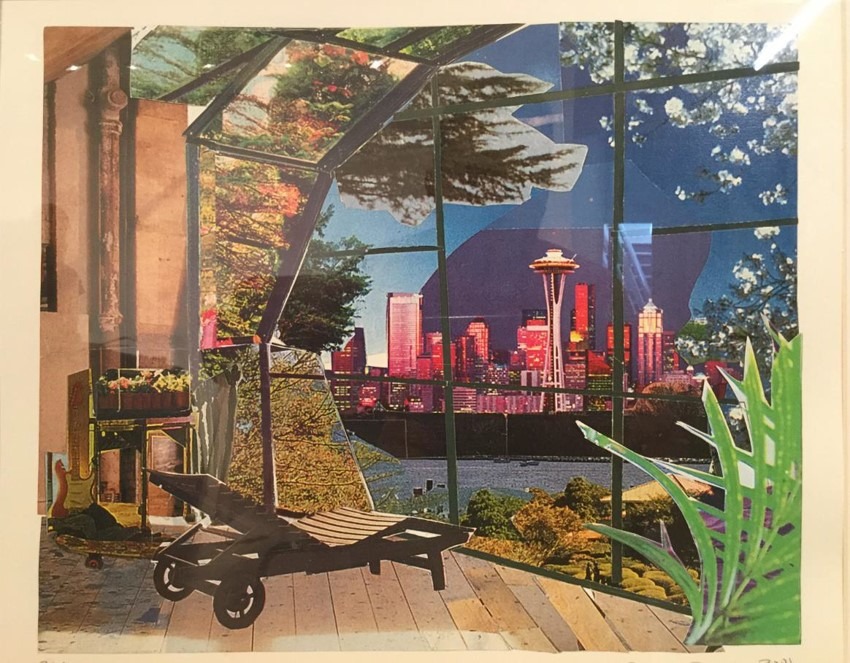
Dexter Dalwood
It’s hard to identify this urban-perfect scene as the suicide site of a grunge god; only the idle guitar and empty chair suggest that somebody is absent. Dexter Dalwood imagines his scenes with the up-close-impersonal sterility of Hello! magazine spotlights; everything needed to know about the person is in the paint. Like Magritte’s Empire of Light, Kurt Cobain’s Greenhouse is both day and night; a lot of time has been spent contemplating in this room. Bright-lights big-city success blares in the distance, the boughs in bloom offer unattainable promise on the other side of the glass. While inside there’s only a corroded pipe and pathetic box of posies to signify trampled self-esteem. Dexter Dalwood’s painting is an allegory of the fallacy of heroism.
Robert Mapplethorpe’s tragic death from AIDS is foretold in Dexter Dalwood’s painting of the photographer’s humble beginnings. Imagining the private life of one of America’s most controversial and respected artists, Dexter Dalwood captures the sublime stark beauty that was intrinsic to his work. Rendered in black and white, Dexter Dalwood’s painting utilises the tones of Mapplethorpe’s photography, and implies a more sinister world of sexuality and violence. Encasing the picture plane with a grid of painted wire, Dexter Dalwood highlights feelings of isolation and persecution. The black bed is a symbol of both sex and death; the mirror, surrounded by the glittering lights of stardom, shows no reflection: a premonition of both promise and loss.
Dexter Dalwood paints London’s swish Grosvenor Square, home to the American embassy, as a comic Armageddon. The sculpture of a dead president stands in ominous glory, a lone caped panto-villain master-minding the elements of world power. Dexter Dalwood pictures this landmark circa 1969: the upside-down trees are taken from a Georg Baselitz painting from this period. Painted during the Iraq war, Dalwood envisions the park as a place of protest, citing the anti-Vietnam demonstrations that took place there. In this epic work Dexter Dalwood captures the enormity of historical resonance: the leaf-strewn grass is weighted with pastoral calmness, giving a grounded continuity of order to the lingering aura of violence.
In his painting of Sunny von Bulow, Dexter Dalwood draws poignant comparison between the New York socialite and Pre-Raphaelite representations of Shakespeare’s Ophelia. Plagued by depression and mental instability, Sunny slipped into an irreversible coma in 1980; her husband, art dealer Claus von Bulow, was initially convicted and later acquitted of attempted poisoning. Here, Dexter Dalwood portrays the heiress as an eternal beauty, trapped in a morbidly poetic slumber. Based on an 1852 painting by John Everett Millais, Dexter Dalwood weaves art-historical reference into contemporary popular conscience, adding gravitas and reverence of legacy to the transient limelight of today’s media culture.
Dexter Dalwood paints famous places he’s never seen: Camp David, Che Guevara’s Mountain Hideaway, Kurt Cobain’s Greenhouse – unseen landmarks of a collective conscious. Dexter Dalwood represents Sharon Tate’s House not as the gory aftermath of the infamous Manson murders, but rather as the ’close-up and impersonal’ interior of a Hello! magazine spread. Creating the perfect ambience, Dexter Dalwood gets into the mind of his subjects by recreating their environment in every detail: the swank late 60s furniture, basked in the warm comfort of a Southern Californian sun. It’s only the feminine dressing table in the background that suggests this is the home of a budding star, and the American flag draped as a subversive sofa cover that indicates this is the site of legendary helter skelter.
Imagining pictures of famous places, Dexter Dalwood invents believable scenes of celebrities’ private lives. In his painting of the Liberace Museum, Dalwood envisions the pianist’s home-cum-shrine as a palace of camp decadence. Acres of pink carpet, swooping staircases, and gilt decoration confirm the viewer’s expectations of the showbiz icon’s personal domain. Dexter Dalwood often incorporates a subtle humour in his work: here bold masculine pinstripes are rendered in garish fuchsia, and a mumsy petit point cushion adorns a distant chair next to a hideous Bambi statue. The absence of Liberace’s grand aura is referenced to in the reflection-less polished floor beneath the piano; the large glimmering crystal in the foreground is a memento of his lasting charisma.
Envisaging America’s best-kept open secret, Dexter Dalwood constructs his version of Camp David as a truly virtual space. In creating the architecture of the presidential retreat, Dexter Dalwood doesn’t present a unified picture, but rather a series of separate paintings within the painting. The bookshelves and lampshades are rendered as free-floating minimalist forms, while the landscapes viewed through the windows show two unrelated types of geography. Dexter Dalwood paints each element with an economical sense of ‘flat-pack’, alluding to theatre props and backdrops. In representing one of the most hallowed emblems of US national security, Dexter Dalwood devises his own spooky conspiracy theory: the possibility that Camp David might not exist at all.
In McCarthy’s List, Dexter Dalwood paints the conservative underbelly of America. Inventing the den of an evangelistic witch-hunter, Dexter Dalwood opts for typical upper-middle-class suburbia, replete with fieldstone bookshelf, Lay-Z-Boy furniture, and catalogue-order globe to monitor the ever-enclosing axis of evil. A portable typewriter sits expectant by his precious amassing volume, being both warmed and threatened by the devil-red fire of communism.
Gorbachev’s Winter Retreat is a modest structure, straddled between the split landscape of old and new Russia. Quoting Edvard Munch (for that Eastern European feel), Dexter Dalwood offers the ousted premier a grim prospect of a lonely, uneventful future as just another forgotten historical figure with nothing but memories, banished to a life of rural idyll and inconsequence.
In his painting of Jackie Onassis’ infamous Mediterranean yacht retreat, Dexter Dalwood has captured the time in a single glance: the over-designed black lacquer tables, the hideous Florida chintz sofa, neo-deco lamps and waterbed. On the wall, Andy Warhol’s diamond dust painting Shoes (Magnin) stamps it all with an exact date: 1980. The painting encompasses all that is perfectly fashionable just like Jackie O herself. It’s only the resounding hollowness of this scene that gives way to thoughts of a tragic heroine: surrounded by all the luxuries money can buy, her only real solace comes from a simple sunset, which she can watch for hours and dream away her grief.
Based on Buckingham Palace intruder Michael Fagan’s 1982 courtroom account of the monarch’s boudoir, Dexter Dalwood’s The Queen’s Bedroom is imagined with forensic accuracy. Painted in proud Union Jack colours, Dexter Dalwood offers a grim and humorous view to the inner life of royalty. Curtains drawn against the outside world, he portrays a meagre loneliness: the lovelessness of a single bed, only the portrait of a long dead relative for company. The spartan décor of the room suggests a regimented existence; the tight-fisted frugality of a ma’am too cheap to foot the gas bill is cheekily implied with the addition of an electric heater on the floor.
In Bay of Pigs, Dalwood recreates the failed 1961 U.S. attempt to overthrow the Cuban government, a haunting tropical image somewhere between vacation brochure and Apocalypse Now. Along the bottom of the canvas, an upside-down version of Picasso’s Déjeuner sur l’herbe stands in for the foreign shore: while the world is in crisis, Picasso is painting palm trees in Cannes. 19.04.61 is engraved on a nearby rock, stolen from a Picasso painting finished that very day.
Room 100 at New York’s Chelsea Hotel is the infamous site of the violent death of Nancy Spungen, allegedly at the hands of her boyfriend Sid Vicious. Dexter Dalwood paints this scene with clinical detachment: the chaotic room is devoid of salacious detail, dehumanised in its simplicity. Dexter Dalwood portrays an unglamorous fantasy of seedy realism as sanitised through media. The composition is riddled with pairs: lamps, cupboard doors and bed frames act as coupled shapes, insinuating an eternal togetherness. The broken bed is symbolic of tragic breakdown. At the foot of the bed is an upturned TV, its image frozen on two black-clad figures: one large and one small, reflective of fragility and ego. On the floor, Dexter Dalwood paints a pool of melting candles, suggestive of drug culture but also the adage that those who shine brightest burn quickest.




